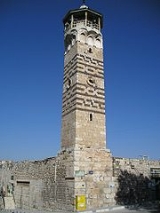
Nur al-Din Mosque
Encyclopedia
The Nur Al-Din Mosque is a Zengid-era mosque
in Hama
, Syria
, located on the banks of the Orontes river. The mosque was erected by Nur ad-Din Zangi in 1172. The square minaret
, made of alternating bands of black basalt and yellow limestone, is the mosque's strongest feature. Inside the mosque, the intricately carved wooden minbar
still stands as one of the oldest preserved testaments to Islamic history.
Mosque
A mosque is a place of worship for followers of Islam. The word is likely to have entered the English language through French , from Portuguese , from Spanish , and from Berber , ultimately originating in — . The Arabic word masjid literally means a place of prostration...
in Hama
Hama
Hama is a city on the banks of the Orontes River in west-central Syria north of Damascus. It is the provincial capital of the Hama Governorate. Hama is the fourth-largest city in Syria—behind Aleppo, Damascus, and Homs—with a population of 696,863...
, Syria
Syria
Syria , officially the Syrian Arab Republic , is a country in Western Asia, bordering Lebanon and the Mediterranean Sea to the West, Turkey to the north, Iraq to the east, Jordan to the south, and Israel to the southwest....
, located on the banks of the Orontes river. The mosque was erected by Nur ad-Din Zangi in 1172. The square minaret
Minaret
A minaret مناره , sometimes مئذنه) is a distinctive architectural feature of Islamic mosques, generally a tall spire with an onion-shaped or conical crown, usually either free standing or taller than any associated support structure. The basic form of a minaret includes a base, shaft, and gallery....
, made of alternating bands of black basalt and yellow limestone, is the mosque's strongest feature. Inside the mosque, the intricately carved wooden minbar
Minbar
A minbar is a pulpit in the mosque where the imam stands to deliver sermons or in the Hussainia where the speaker sits and lectures the congregation...
still stands as one of the oldest preserved testaments to Islamic history.

